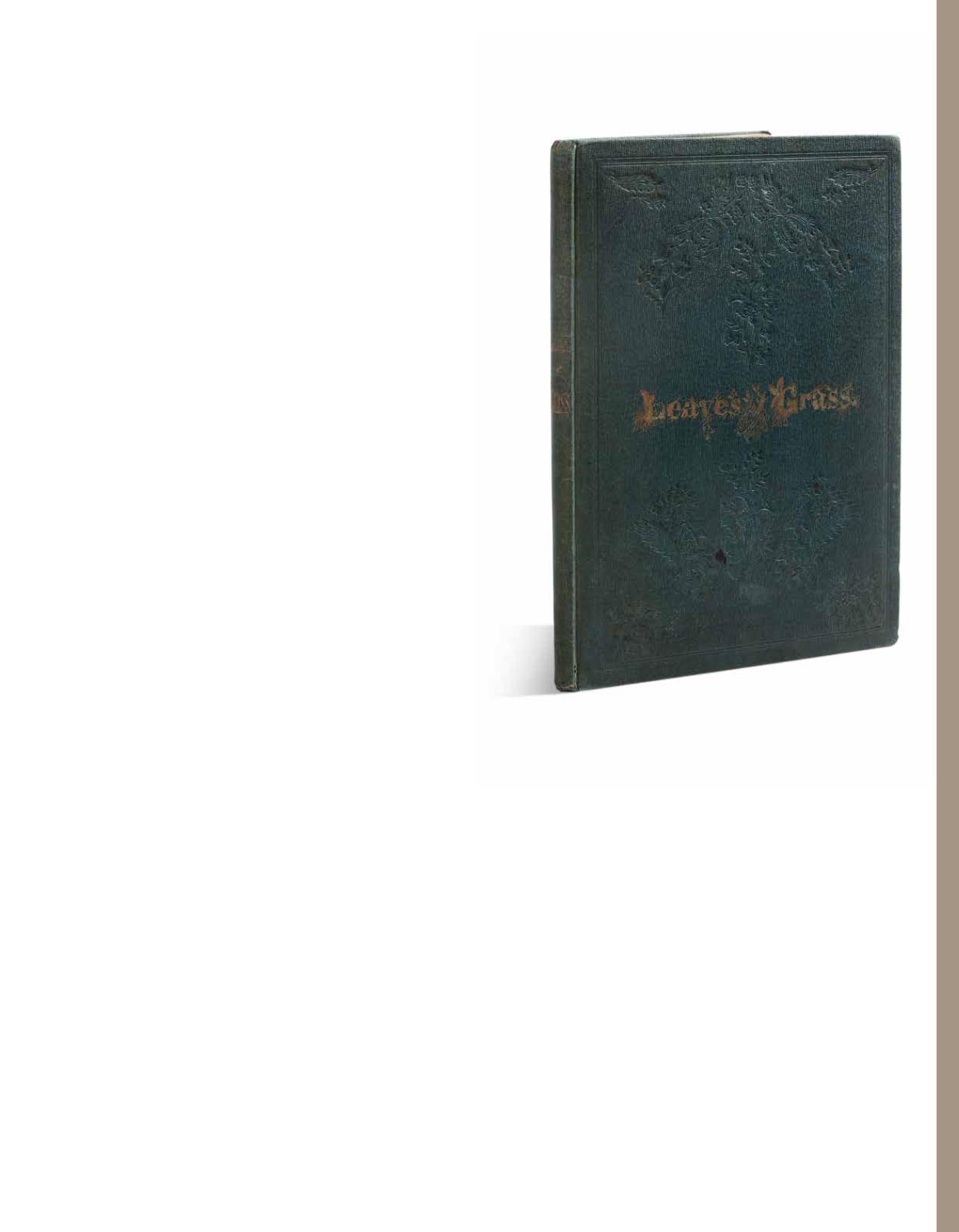

237
britannica - americana
WHITMAN WALT
(1819-1892).
Leaves of Grass
Brooklyn, New York, [James and Thomas Rome paid
for by Walt Whitman himself], 1855.
Small folio format, flyleaf + with (4) ff. printed newspaper
articles (excerpts: letters and reviews), 1 frontispiece portrait
(Hollyer engraving), 95 pp. + 2 flyleaves. Bound in a green
cloth binding with gilt lettering (Binding “State B”: green
cloth with less ornate stamping, see Myerson). Half green
morocco articulated case, gilt lettering on the spine, cloth
covered boards. Some wear to the binding, minimal; an ink
stain on upper board; some foxing to paper. Dimensions of
binding 205 x 290 mm.
30 000 / 40 000 €
First edition, second issue of Whitman’s
Leaves of Grass.
Printing and the Mind of Man
340. – Grolier
100 Influential American
Books
67. – Myerson,
Walt Whitman: A Descriptive Bibliography (1993).
This is the same exemplar as the Myerson Collection (University of
South Carolina): “The significance of variant bindings while some
copies were issued in paper wrappers, most were bound in green
cloth, stamped with a pattern of leaves and ferns, and with differing
degrees of gilt. The binding variants are evidence that, even with
Whitman’s energetic promotion, the book sold slowly and copies
were bound in batches” (
Leaves of Grass at 150. An exhibition chiefly
from the Joel Myerson Collection of Nineteenth-Century American
Literature.
University of South Carolina, 2005).
Frontispiece portrait of Walt Whitman opposite of the title page,
signed in brown ink below. Signed copies of the 1855
Leaves
are a
rarity. The author Walt Whitman does not appear on the title page
but is found on the copyright page.
The importance of the first edition of
Leaves of Grass
to American
literary history is impossible to exaggerate. The slender volume
introduced the poet who, celebrating the nation by celebrating himself,
has since remained at the heart of America’s cultural memory. As
Leaves of Grass grew through its five subsequent editions into a hefty
book of 389 poems (with the addition of the two annexes), it gained
much in variety and complexity, but Whitman’s distinctive voice was
never stronger, his vision never clearer, and his design never more
improvisational than in the twelve poems of the first edition. Composed
in free verse around themes of identity, love, sexuality, democracy,
loss, and death,
Leaves of Grass
was Whitman’s lifelong work.
Among the poems in the collection are “Song of Myself,” “I Sing the
Body Electric,” “Out of the Cradle Endlessly Rocking,” and in later
editions, Whitman’s elegy to the assassinated President Abraham
Lincoln, “When Lilacs Last in the Dooryard Bloom’d.” Whitman spent
his entire life writing
Leaves of Grass
, revising it in several editions until
his death. The first edition published in 1855 contained 12 poems on
95 pages. The final edition published contained almost 400 poems.
The 1855
Leaves of Grass
, while published without Whitman’s name
on the title page or binding, did bear his identity in three ways: the
book’s copyright notice is in his name, he identifies himself as “Walt
Whitman, an American, one of the roughs, a kosmos” in the text, and
the Hollyer engraving of Whitman serves as the book’s frontispiece.
“Always the champion of the common man, Whitman is both the poet
and the prophet of Democracy. The whole of
Leaves of Grass
is imbued
with the spirit of brotherhood and a pride in the democracy of the
young American nation. In a sense, it is America’s second Declaration
of Independence: that of 1776 was political, that of 1855 intellectual.
As the preface to the first edition puts it, the poems are saturated «
with a vehemence of pride and audacity of freedom necessary to
loosen the mind of still-to-be-fomed America from the folds, the
superstitions, and all the long, tenacious, and stifling anti-democratic
authorities of Asiatic and European past ». To the young nation, only
just becoming aware of an individual literary identity distinct from its
European origins, Whitman’s message and his outspoken confidence
came at the decisive moment” (
Printing and the Mind of Man,
nº 340).
According to the bookbinder’s records as recounted by Myerson,
795 copies were bound. Whitman reported that 800 were printed.
The first 200 were bound in June 1855 in binding A (green cloth with
extra gilt stamping and all edges gilt). In December 1855 to January
1856, another 262 copies were bound in binding B (green cloth with
less ornate stamping), and at this same time another 150 copies were
bound in binding C (paper wrappers).
provenance
1. John Townsend Burwell (born 1878), his heraldic ex-libris bookplate
and his autograph signature on verso of flyleaf. On the bookplate, an
inscription in ink : “A first edition” – 2. Dominique de Villepin (born
1953), diplomat and former French minister, his sale
. Feux & flammes.
Un itinéraire politique. I Les Voleurs de feu
(28 November 2013, n° 55).
















